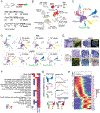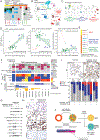Lineage plasticity in prostate cancer depends on JAK/STAT inflammatory signaling
- PMID: 35981096
- PMCID: PMC9653178
- DOI: 10.1126/science.abn0478
Lineage plasticity in prostate cancer depends on JAK/STAT inflammatory signaling
Abstract
Drug resistance in cancer is often linked to changes in tumor cell state or lineage, but the molecular mechanisms driving this plasticity remain unclear. Using murine organoid and genetically engineered mouse models, we investigated the causes of lineage plasticity in prostate cancer and its relationship to antiandrogen resistance. We found that plasticity initiates in an epithelial population defined by mixed luminal-basal phenotype and that it depends on increased Janus kinase (JAK) and fibroblast growth factor receptor (FGFR) activity. Organoid cultures from patients with castration-resistant disease harboring mixed-lineage cells reproduce the dependency observed in mice by up-regulating luminal gene expression upon JAK and FGFR inhibitor treatment. Single-cell analysis confirms the presence of mixed-lineage cells with increased JAK/STAT (signal transducer and activator of transcription) and FGFR signaling in a subset of patients with metastatic disease, with implications for stratifying patients for clinical trials.
Figures





Comment in
-
Drivers of lineage plasticity.Nat Rev Cancer. 2022 Nov;22(11):605. doi: 10.1038/s41568-022-00524-8. Nat Rev Cancer. 2022. PMID: 36207488 No abstract available.
-
Cytokines drive prostate cancer lineage plasticity.Immunity. 2022 Oct 11;55(10):1761-1763. doi: 10.1016/j.immuni.2022.09.011. Immunity. 2022. PMID: 36223725
References
-
- V Sequist L, Waltman BA, Dias-Santagata D, Digumarthy S, Turke AB, Fidias P, Bergethon K, Shaw AT, Gettinger S, Cosper AK, Akhavanfard S, Heist RS, Temel J, Christensen JG, Wain JC, Lynch TJ, Vernovsky K, Mark EJ, Lanuti M, Iafrate AJ, Mino-Kenudson M, Engelman JA, Genotypic and histological evolution of lung cancers acquiring resistance to EGFR inhibitors. Sci Transl Med. 3, 75ra26 (2011). - PMC - PubMed
-
- Awad MM, Liu S, Rybkin II, Arbour KC, Dilly J, Zhu VW, Johnson ML, Heist RS, Patil T, Riely GJ, Jacobson JO, Yang X, Persky NS, Root DE, Lowder KE, Feng H, Zhang SS, Haigis KM, Hung YP, Sholl LM, Wolpin BM, Wiese J, Christiansen J, Lee J, Schrock AB, Lim LP, Garg K, Li M, Engstrom LD, Waters L, Lawson JD, Olson P, Lito P, Ou S-HI, Christensen JG, Jänne PA, Aguirre AJ, Acquired Resistance to KRAS G12C Inhibition in Cancer . New England Journal of Medicine. 384, 2382–2393 (2021). - PMC - PubMed
-
- Bluemn EG, Coleman IM, Lucas JM, Coleman RT, Hernandez-Lopez S, Tharakan R, Bianchi-Frias D, Dumpit RF, Kaipainen A, Corella AN, Yang YC, Nyquist MD, Mostaghel E, Hsieh AC, Zhang X, Corey E, Brown LG, Nguyen HM, Pienta K, Ittmann M, Schweizer M, True LD, Wise D, Rennie PS, Vessella RL, Morrissey C, Nelson PS, Androgen Receptor Pathway-Independent Prostate Cancer Is Sustained through FGF Signaling. Cancer Cell. 32, 474–489.e6 (2017). - PMC - PubMed
MeSH terms
Substances
Grants and funding
LinkOut - more resources
Full Text Sources
Medical
Molecular Biology Databases

